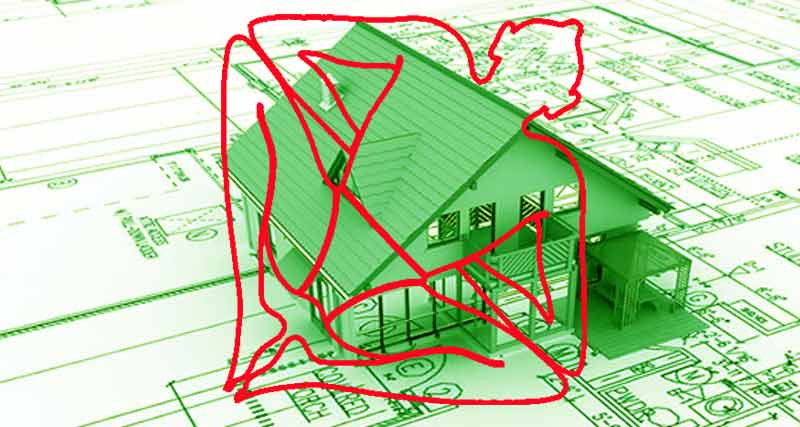Home : Articles :: These are the steps to start construction according to vastu
These are the steps to start construction according to vastu

Vishwakarma the Chief Architect was appointed by the Creator Brahma for the help of Prithu, the first emperor of the world and he ordered Prithu, not to exploit the powers of the earth according to one’s whims and fancies but only after the wise advise of Vishwakarma. So Vishwakarma was given the rights to enforce the rules and regulations of the Vastu and he himself could envisage the technical part of the construction without any fear of the royal authority. Vishwakarma was given the responsibility to manifest the divinity of the deities into all the Padas of the land according to the Great plan of the Creator Brahma.
Preparation of land Construction:
The origin of the Vastu Purusha Mandal can be traced back to the Vedic Customs and traditions. The Art of building-construction emanated from the Vedic Fire Altar used to give sacrifices to the deities. Here we find the existence of Yajna Purusha in the scheme of vedic rites, where oblations or sacrifices were offered to the fire of yajna. These sacrifices (oblations or offerings ) are three fold namely (i) material (ii) non-material and (iii) sacrifices.
Emergence of Preliminary Preparatory Steps:
Social principles and procedures were adopted for constructing Yajna-vedis (Altars for oblations or offerings in the fire). The essential steps for making Altars were:-
(i) Selection of the land (ii) Purification of the land (iii) Ishtika Karm (iv) Ishtika chayan which later on became the important steps in Vastu also.
The foundation of Yupa (a wooden column) in Altar-construction gave birth to the concept of foundation of central pillar.
Moral codes of Vastu and their implementation.
The evolution of the basic principles of construction also gave way to the necessity to make them implemented by the masses as their moral responsibility. This was achieved easily and spontaneously as in Hindu Culture every act or establishment is provided with the philosophical base and it is divinised by giving it a divine outlook. This is achieved by creating proportional and rhythmic beauty in the creation which becomes the embodiment of divine manifestation. The general masses are religious and have faith in the traditional values and this helps to make them follow the important rules of Vastu.
This clearly differentiates Vastu and Architecture as the former has philosophical and spiritual roots while the later is only technical in nature. The Mantras given in Rigaveda which is to be recited in the beginning of the construction is still retained in its original form.
Philosophy behind the Rules of construction.
The evolution of Vastu Purusha is the embodiment of its evolution from the Asura (Yonic lower mental plane) and to attain this high order he had to take shelter of Brahma, the Creator God. But the deities did not agree to his evolution easily and still guard his body or all the vastu squares of the land and give unfavourable results if any construction is carried out in a specific unit against the basic nature of the deity ruling that unit. To attain best results it becomes essential to carry out the construction in each unit of the land according to the nature of the deity of that unit of the land.
Preparation of land Construction:
The origin of the Vastu Purusha Mandal can be traced back to the Vedic Customs and traditions. The Art of building-construction emanated from the Vedic Fire Altar used to give sacrifices to the deities. Here we find the existence of Yajna Purusha in the scheme of vedic rites, where oblations or sacrifices were offered to the fire of yajna. These sacrifices (oblations or offerings ) are three fold namely (i) material (ii) non-material and (iii) sacrifices.
Emergence of Preliminary Preparatory Steps:
Social principles and procedures were adopted for constructing Yajna-vedis (Altars for oblations or offerings in the fire). The essential steps for making Altars were:-
(i) Selection of the land (ii) Purification of the land (iii) Ishtika Karm (iv) Ishtika chayan which later on became the important steps in Vastu also.
The foundation of Yupa (a wooden column) in Altar-construction gave birth to the concept of foundation of central pillar.
Moral codes of Vastu and their implementation.
The evolution of the basic principles of construction also gave way to the necessity to make them implemented by the masses as their moral responsibility. This was achieved easily and spontaneously as in Hindu Culture every act or establishment is provided with the philosophical base and it is divinised by giving it a divine outlook. This is achieved by creating proportional and rhythmic beauty in the creation which becomes the embodiment of divine manifestation. The general masses are religious and have faith in the traditional values and this helps to make them follow the important rules of Vastu.
This clearly differentiates Vastu and Architecture as the former has philosophical and spiritual roots while the later is only technical in nature. The Mantras given in Rigaveda which is to be recited in the beginning of the construction is still retained in its original form.
Philosophy behind the Rules of construction.
The evolution of Vastu Purusha is the embodiment of its evolution from the Asura (Yonic lower mental plane) and to attain this high order he had to take shelter of Brahma, the Creator God. But the deities did not agree to his evolution easily and still guard his body or all the vastu squares of the land and give unfavourable results if any construction is carried out in a specific unit against the basic nature of the deity ruling that unit. To attain best results it becomes essential to carry out the construction in each unit of the land according to the nature of the deity of that unit of the land.




















